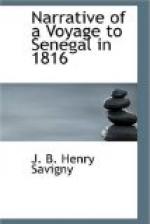[2] Equipped at Brent.
[3] Came from L’Orient.
[4] The town of Chassiron is on the point of Oleron, opposite a bank of rocks called Les Antiochats.
[5] The light house of La Baleine is placed at the other end of the Pertuis d’Antioche, on the coast of the Isle of Rhe.
[6] Les Roches Bonnes are 8 or 9 leagues from the Isle of Rhe, their position is not exactly determined on the charts.
[7] Three knots make a marine league of 5556 meters.
[8] These are very large fish which every moment appear on the surface of the water, where they tumble about. They pass with such prodigious rapidity, that they will swim round a ship, when it is going at the rate of nine or ten knots an hour.
[9] The life buoy, is made of cask staves hooped together, and is about a metre (something more than a yard.) in diameter, in the middle of which is a little mast to fix a flag to. It is thrown into the sea, as soon as a man falls overboard, that he may place himself upon it while the operation of lowering a boat down, or heaving the, vessel to, is performed.
[10] We do not know why the government makes its vessels take this route; when one can proceed directly to the Canaries: it is true they are often obscured by mists, but there are no dangers in the principal canals which they form, and they extend over so large a space that it is impossible not to recognise them, with facility. They have also the advantage of being placed in the course of the monsoons; though however, west winds sometimes blow for several days together. We think that vessels going to the East Indies might dispense with making Madeira and Porto Santo, the more so as there are many shoals near these islands; besides the rocks, of which we have spoken above there is another, to the N. E. of Porto Santo, on which many vessels have been lost; by night all these reefs are very dangerous, by day they are recognised by the breakers on them.
[11] This route was not recommended by the instructions, but there was on board an old sea officer, who announced himself as a pilot in these seas; his advice was unfortunately attended to.
[12] A description of the reef of Arguin may be found in the Little Sea Torch.
[13] Besides the instructions given by the Minister, for sailing, after having made Cape Blanco, there was a letter sent some days before our departure from the road of the Isle of Aix, recommending the commander of the expedition not to depend upon the Charts, upon which the reef is very erroneously placed.
[14] Mr. Laperere, the officer on the watch before Mr. Maudet, found by his reckoning, that we were very near the reef; he was not listened to, though he did his utmost, at least to ascertain our situation by sounding. We have mentioned the names of Messrs. Laperere and Maudet, because if they had been attended to, the Medusa would be still in existence.




